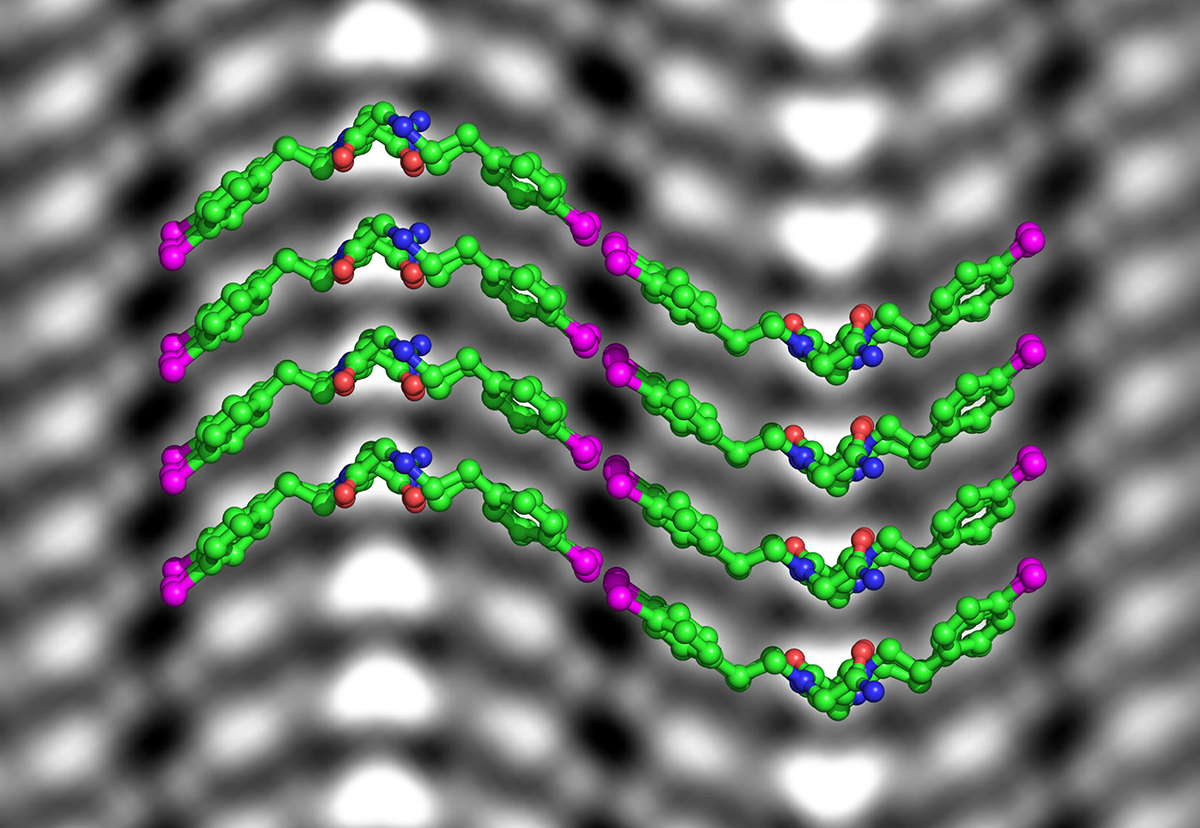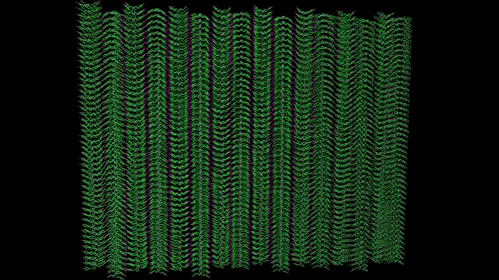
Berkeley Lab scientists employed cryogenic electron microscopy (cryo-EM) to reveal the atomic structure of peptoid nanosheets. Their use of cryo-EM allowed them to visualize distinct bromine atoms (magenta) in the peptoid’s side chains. (Credit: Berkeley Lab)
Protein-like molecules called “polypeptoids” (or “peptoids,” for short) have great promise as precision building blocks for creating a variety of designer nanomaterials, like flexible nanosheets – ultrathin, atomic-scale 2D materials. They could advance a number of applications – such as synthetic, disease-specific antibodies and self-repairing membranes or tissue – at a low cost.
To understand how to make these applications a reality, however, scientists need a way to zoom in on a peptoid’s atomic structure. In the field of materials science, researchers typically use electron microscopes to reach atomic resolution, but soft materials like peptoids would disintegrate under the harsh glare of an electron beam.
Now, scientists at the U.S. Department of Energy’s Lawrence Berkeley National Laboratory (Berkeley Lab) have adapted a technique that enlists the power of electrons to visualize a soft material’s atomic structure while keeping it intact.
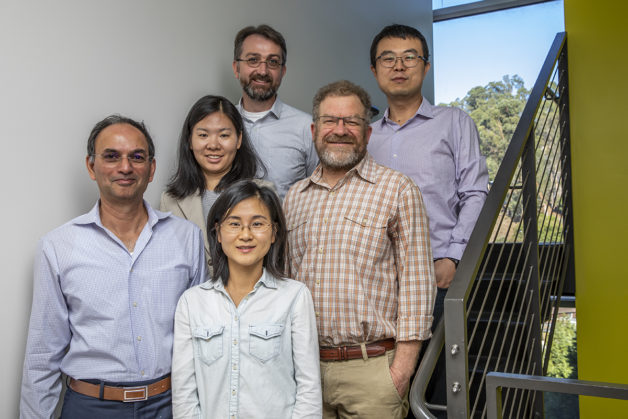
Nitash Balsara (clockwise from left), Nan Li, David Prendergast, Xi Jiang, Ronald Zuckermann, and Sunting Xuan used cryogenic electron microscopy to atomically engineer and image a peptoid crystal. (Credit: Marilyn Sargent/Berkeley Lab)
Their study, published in the journal Proceedings of the National Academy of Sciences, demonstrates for the first time how cryo-EM (cryogenic electron microscopy), a Nobel Prize-winning technique originally designed to image proteins in solution, can be used to image atomic changes in a synthetic soft material. Their findings have implications for the synthesis of 2D materials for a wide variety of applications.
“All materials we touch function because of the way atoms are arranged in the material. But we don’t have that knowledge for peptoids because unlike proteins, the atomic structure of many soft synthetic materials is messy and hard to predict,” said Nitash Balsara, a senior faculty scientist in Berkeley Lab’s Materials Sciences Division, and professor of chemical engineering at UC Berkeley, who co-led the study. “And if you don’t know where the atoms are, you’re flying blind. Our use of cryo-EM for the imaging of peptoids will set a clear path for the design and synthesis of soft materials at the atomic scale.”
Taking a close look at soft materials
For the last 13 years, Balsara has been leading an effort to image soft materials at the atomic scale through Berkeley Lab’s Soft Matter Electron Microscopy Program. For the current study, he joined forces with Ronald Zuckermann, a senior scientist in Berkeley Lab’s Molecular Foundry who first discovered peptoids almost 30 years ago in his search for new polymers – materials made of long, repeating chains of small molecular units called “monomers” – for targeted drug therapies.
“This study comes out of many years of research here at Berkeley Lab. To make a material and see the atoms – it’s the dream of my career,” said Zuckermann, who co-led the study with Balsara.

Ronald Zuckermann holding a 3D model of a peptoid structure at the Molecular Foundry. He and his team used cryo-EM to engineer and visualize the peptoid’s atomic structure. (Credit: Marilyn Sargent/Berkeley Lab)
Unlike most synthetic polymers, peptoids can be made to have a precise sequence of monomer units, a common trait in biological polymers, such as proteins and DNA.
And like natural proteins, peptoids can grow or self-assemble into distinct shapes for specific functions – such as helices, fibers, nanotubes, or thin and flat nanosheets.
But unlike proteins, the molecular structure of peptoids is typically amorphous and unpredictable – like a pile of wet noodles. And untangling such an unpredictable structure has long been an obstacle for materials scientists.
Pinning down peptoids with cryo-EM
So the researchers turned to cryo-EM, which flash-freezes the peptoids at a temperature of around 80 kelvins (or minus 316 degrees Fahrenheit) in microseconds. The ultracold temperature of cryo-EM locks in the structure of the sheet and also prevents the electrons from destroying the sample.
To protect soft materials, cryo-EM uses fewer electrons than conventional electron microscopy, resulting in ghostly black-and-white images. To better document what’s going on at the atomic level, hundreds of these images are taken. Sophisticated mathematical tools combine these images to make more detailed atomic-scale pictures.
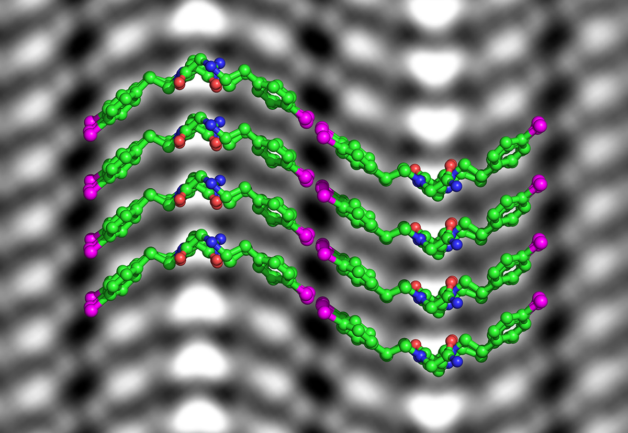
Short peptoid polymer chains (green) stacked in a nanosheet crystal lattice are overlaid on a cryo-EM image (grayscale image). Bromine atoms on the peptoid side chains are shown in magenta. (Credit: Berkeley Lab)
For the study, the researchers fabricated nanosheets in solution from short peptoid polymers made of a chain of six hydrophobic monomers known as “aromatics,” connected to four hydrophilic polyether monomers. The hydrophilic or “water-loving” monomers are attracted to the water in the solution, while the hydrophobic or “water-hating” monomers avoid the water, orienting the molecules to form crystalline nanosheets that are only one-molecule thick (around 3 nanometers, or 3 billionths of a meter).
Lead author Sunting Xuan, a postdoctoral researcher in the Materials Sciences Division, synthesized the peptoid nanosheets and used X-ray scattering techniques at Berkeley Lab’s Advanced Light Source (ALS) to characterize their molecular structure. The ALS produces light in a variety of wavelengths to enable studies of samples’ nanoscale structure and chemistry, among other properties.
Xi Jiang, a project scientist in the Materials Sciences Division, captured the high-quality images and developed the algorithms necessary to achieve atomic resolution in the peptoid imaging.
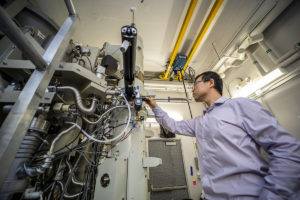
Xi Jiang shown with the cryogenic transmission electron microscope at UC Berkeley’s Donner Lab. (Credit: Marilyn Sargent/Berkeley Lab)
David Prendergast, senior staff scientist and interim director of the Molecular Foundry, modeled atomic substitutions in the peptoids. Nan Li, a postdoctoral researcher at the Molecular Foundry, and Ryan Spencer of UC Irvine performed molecular dynamics simulations to establish an atomic-scale model of the nanosheet.
At the heart of the team’s discovery was their ability to rapidly iterate between materials synthesis and atomic imaging. The precision of peptoid synthesis, coupled with the researchers’ ability to directly image the placement of atoms using cryo-EM, allowed them to engineer the peptoid at the atomic level. To their surprise, when they created several new variations of the peptoid monomer sequence, the atomic structure of the nanosheet changed in a very orderly way.
For example, when one additional bromine atom was added to each aromatic ring, the shape of each peptoid molecule remained unchanged yet the space between rows increased by just enough to accommodate the additional bromine atoms.
Furthermore, when four additional variants of the peptoid nanosheet structure were imaged, the researchers noticed a remarkable uniformity across their atomic structure, and that the nanosheets shared the same shape of peptoid molecules. This allowed them to predictably engineer the nanosheet structure, Zuckermann said.
“To have so much control at the atomic scale in soft materials was completely unexpected,” said Balsara, because it was assumed that only proteins could form defined shapes when you have a specific sequence of monomers – in their case, amino acids.
A team approach to new materials
For close to four decades, Berkeley Lab has pushed the boundaries of electron microscopy into fields of science once considered impossible to explore with an electron beam. Pioneering work by scientists at Berkeley Lab also played a key role in the 2017 Nobel Prize in chemistry, which honored the development of cryo-EM.
“Most people would say it’s not possible to develop a technique that can position and see individual atoms in a soft material,” said Balsara. “The only way to solve hard problems like this is to team up with experts across scientific disciplines. At Berkeley Lab, we work as a team.”
Zuckermann added that the current study proves that the cryo-EM technique could be applied to a wide range of common polymers and other industrial soft materials, and could lead to a new class of soft nanomaterials that fold into protein-like structures with protein-like functions.
“This work sets the stage for materials scientists to tackle the challenge of making artificial proteins a reality,” he said, adding that their study also positions the team to work on solving a diversity of exciting problems, and to “raise people’s awareness that they, too, can begin to look at the atomic structure of their soft materials using these cryo-EM techniques.”
Researchers from Berkeley Lab, UC Berkeley, and UC Irvine participated in the work.
This work was supported by the DOE Office of Science through the Soft Matter Electron Microscopy Program.
The Molecular Foundry, which specializes in nanoscale science, and the Advanced Light Source are DOE Office of Science user facilities.
###
Founded in 1931 on the belief that the biggest scientific challenges are best addressed by teams, Lawrence Berkeley National Laboratory and its scientists have been recognized with 13 Nobel Prizes. Today, Berkeley Lab researchers develop sustainable energy and environmental solutions, create useful new materials, advance the frontiers of computing, and probe the mysteries of life, matter, and the universe. Scientists from around the world rely on the Lab’s facilities for their own discovery science. Berkeley Lab is a multiprogram national laboratory, managed by the University of California for the U.S. Department of Energy’s Office of Science.
DOE’s Office of Science is the single largest supporter of basic research in the physical sciences in the United States, and is working to address some of the most pressing challenges of our time. For more information, please visit energy.gov/science.
